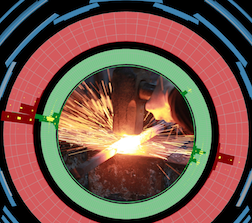Despite the absence of experimental evidence, weak scale supersymmetry remains one of the best motivated and studied Standard Model extensions. This talk summarises recent ATLAS searches for supersymmetric squarks and gluinos, including third generation squarks produced in the decay of gluinos. The searches have been performed on the pp collisions collected at 13 TeV center of mass energy and...
Theories beyond the standard model such as Supersymmetry (SUSY) predict the existence of additional particles. Cascade decays of SUSY particles often yield final states with hadronic activity and missing transverse energy.
Signatures including leptons are of particular interest since standard model processes are suppressed by this selection and can be predicted with good accuracy.
An...
The latest results from supersymmetry searches performed at CMS at 13 TeV in final states characterized by the presence of either a pair of same-sign charged leptons (muons or electrons), or by the presence of at least 3 charged leptons are presented. The studies focus particularly in the search for gluino pair production, and the results are interpreted in the context of simplified models of...
Contrary to common expectations, a left-sneutrino can turn out to be the
lightest supersymmetric (SUSY) particle (LSP), if there is a mass-splitting
between the CP-even and-odd components of the complex sneutrino field(s).
A signal expected of the ensuing SUSY spectrum, over a large region of the
parameter space, is same-sign trileptons at the LHC. The jets + MET signal
...
The new energy regime reached at the LHC with the Run1 is a unique chance to look for the production of new massive particles, predicted by many beyond-Standard-Model theories. Among these, Supersymmetry (SUSY) is particularly favourable because it provides a solution to the hierarchy problem, it ensures gauge coupling unification and provides a candidate for dark matter. The Run 2 of LHC has...
In this talk, the latest results on searches for supersymmetry in final states with photons are presented using data recorded by the CMS experiment. A variety of complementary final state signatures and methods are used to probe gluino, squark and electroweak production of supersymmetric particles.
